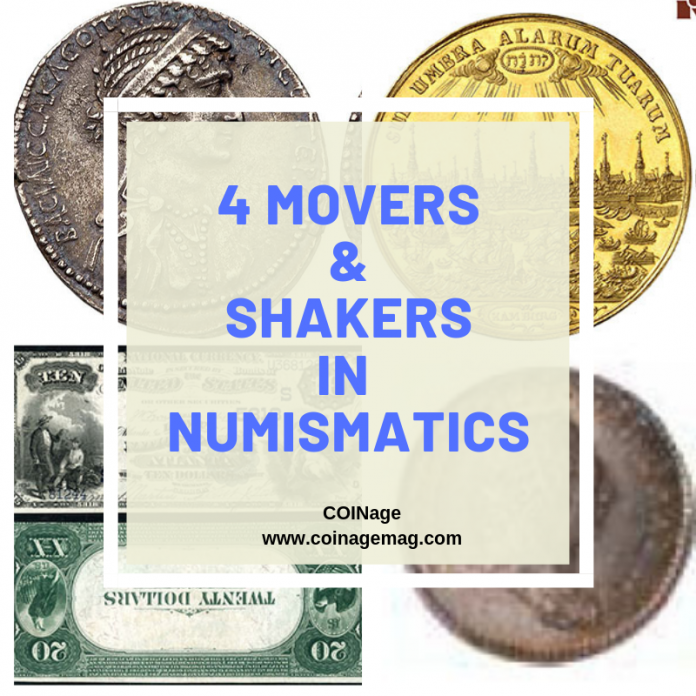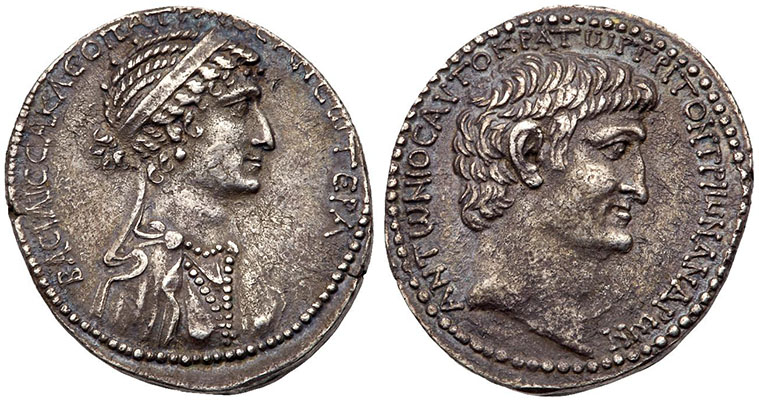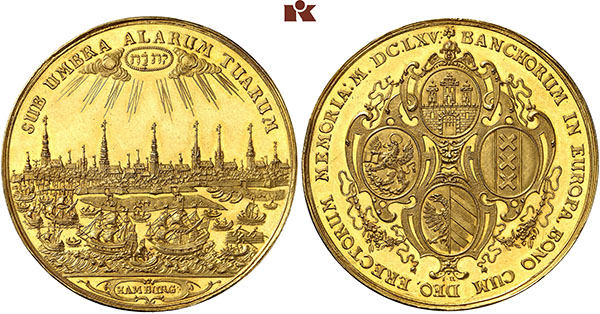
By Antoinette Rahn
How often do you take time to appreciate the artistry of coins and currency? I ask because admittedly when I was first introduced to numismatics I did not consider it to be a collecting field where artistry played much of a part. This is a good example of what our grade school principal, Sister Pat McCormick, would call ‘missing important facts due to impatience.’ I may or may not have heard that phrase used to describe my approach to learning a time or two in the three years she was the principal of the school.
Dear Sister Pat, if you are still with us here on earth and happen to have become a fan of numismatics, I can report that I am an incredibly patient adult, and I have indeed done what you told me often during my youth: ‘use my powers of creativity and influence for good.’ Most of the time I’ve done that.
However, let’s get on to this week’s ‘4 Movers & Shakers in Numismatics’ that brought to mind the artistry of coins and currency, which is something I’ve come to greatly appreciate as my interest in the hobby has grown.
$10/$20 1882VB Double Denomination Pair
Presented for auction Nov. 13, 2018, by Lyn Knight Auctions
Sold for $75,000 (w/buyer’s premium) against an estimate of $75,000.00 – $ 150,000.00
There is a lot about this pair of notes that caught my eye and reminds me of how fascinating and important details can be, even on a space as small as a coin or note. Each of the notes in this pair hail from a sheet of National Bank Notes (The Lowry National Bank of Atlanta) that have the backs flipped and the faces printed right side up. In addition, one of the notes presents with a $10 face and $20 back, while the other shows the opposite ($20 front and $10 back), creating a singular note with a $30 value, according to the description in the auction catalog. The vignettes on the face are quite striking as well, with what is described by many sources as “Franklin and Electricity” on the left and “America Seizing Lightning,” on the right. At closer inspection, at the corner of the “Franklin and Electricity” vignette, the year 1752 appears, which has been known to trip people up when it comes to confirming the date of this note, which is indeed 1882.
Silver Tetradrachm, 36 BC, Mark Antony, and Cleopatra
To be presented for sale at auction Jan. 8, 2019, by Ira & Larry Goldberg Auctioneers
Estimate: $50,000
Ancient coins are incredibly intriguing, in my humble opinion, for a couple of reasons. The thing I find most interesting is that whoever created the coins did so with limited tools. Yet, the coins give us clues and often clear details about the life, time and peoples of long, long ago.
With more than 1,000 lots of timeless ancient coins coming to the auction block during Goldberg Auctioneers’ Jan. 8 sales, it’s not a matter of finding one that catches the eye, but at what point does one stop counting? For me, it was Lot 244. On one side is a draped bust of Cleopatra VII, who was the last queen to rule the Ptolemaic kingdom and the subject of much research and efforts to immortalize the woman said to have been a tremendous figure in ancient history. That is evident in the depiction of the queen on this silver tetradrachm (silver coin in use in ancient Greece). The bust appears to adorned in royal attire and jewels, which is confirmed in the auction catalog that lists her wearing a diadem — which is a jeweled headband typically worn by kings during ancient times, but given what history has revealed about Cleopatra and her quest for power, the diadem seems logical. Interestingly, Marc Antony appears on opposite Cleopatra on the other side of the coin, but the bust appears bareheaded.
These two powerful personalities had a decidedly complex relationship not only with one another but other leaders and the people of the age. The catalog description for this lot speaks of this. Three cheers for the value of catalog descriptions!
Bankportugalöser zu 10 Dukaten 1665
To be presented for sale at auction Jan. 31, 2019, Künker Auction House
Estimate: 20,000 € ($22,612)
This gold 10 ducat dating to 1665 is a pretty spectacular example of artistry in miniature. The obverse of this coin appears to depict the scene of a seaport in Hamburg, Germany bustling with shipping activity, which remains true today. In fact, according to information reported at www.marineinsight.com, the Port of Hamburg is the leading port in Germany, second largest port in Europe, and ranked 11th most active in the world in terms of shipping container capacity. It is no wonder why it’s long been known as the ‘Gateway to the World.’
This coin beautifully demonstrates this fact of long-held national purpose and pride, and even seems to speak to the harbor being celebrated by heavenly hosts, with the name of Jehovah appearing in the clouds, surrounded by rays of light, and the Latin phrase SUB UMBRA ALARUM TUARUM (UNDER THE SHADOW OF YOUR WINGS) spanning across the cityscape. On the reverse appears an equally stunning presentation of the coats of arms of the four banking cities of Europe: Hamburg, Venice, Amsterdam, and Nuremberg. Artistry and history on a space that measures slightly less than 50 mm.
Set of George III Maundy Coins, 1786
To be presented for sale at auction Jan. 13, 2019, Baldwin’s of St. James’s
Estimate: 20,000 € ($22,612)
This set is one of a few lots featuring Maundy coins reportedly making their inaugural appearance at auction, having been stored since the 18th century. I don’t know about you, but that kind of tidbit of information always piques my interest, as I wonder: Where were these coins? Why were they stored away? Regardless, it’s quite exciting for the bidding public who will have the opportunity to perhaps acquire one or a set of these unique coins.
Since I was not certain if Maundy coins did indeed have a connection with the Christian ceremony preceding Good Friday and Easter, I did some research. Turns out they do and are the focal point of a ceremony still in effect today, according to information obtained at The Royal Mint website.
According to The Royal Mint site, The Royal Maundy is a ceremony inspired by that of what is detailed in the Bible about Jesus Christ washing the feet of his disciples on the day before Good Friday, the day of his death. Over the centuries Britain’s Royal Family has participated in a similar ceremony of compassion. With the arrival of Henry IV, a new tradition was created, which involved gifts of to subjects on Maundy. This evolved into Maundy money ceremonies during the rule of Charles II. The Maundy money given to people of the kingdom included a fourpence, threepence, twopence, and a penny.
Among the lots of Maundy coins on offer in Baldwin’s Jan. 13 sale is this complete set of Maundy coins from 1786, during the reign of George III.
Not that there needs to a moral to this installment of ‘4 Movers & Shakers in Numismatics,’ but if there was, I think Sister Pat might very well say the delights (certainly not the devil) is in the details.


















